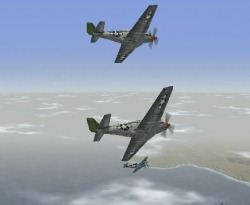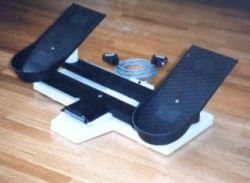| Simped Rudder Pedals by Michael Ackermann |
||||
|
Summary :
Test system :
Sims tested : EAW, CFS, WWII Fighters, Longbow 2, FS98. Simped Rudder pedals? Hoffman Electronics? Never heard of either? Well, then you are in the same position as I was seeing the first information about their pedals. Hoffman Electronics is a small company located in beautiful Southern Bavaria / Germany. That's where (among other things) the famous Weiss-Beer and the most strange German dialect come from. They specialize in individual electronics solutions, so if you need something special, they try to make it for you. Mr. Hoffmann is a PPL pilot like me and was disappointed with the pedals on the market, so he decided to make some for himself. They turned out so well that he decided to offer them to the PC simulation market. He was right; the pedals on the market either feel choppy or lack the coordination of rudder input vs. sim reaction. Nothing comes quite close to the real thing, and the bunch of recently released WW2 sims creates a special need for good pedals. With my old CH pedals my EAW Wingmen must be really nervous about my Formation flying skills :-). So I ordered the pedals immediately and got a small package two days later. What do you get? Well, the rudder base itself is manufactured from high grade plastics and a casing with a filler similar to ceramics. Looks nice. Two black footrests with screws to mount them on the base, and included are a set of velcros and a 10 page manual. Installation is easy, the footrests can be installed in two positions for either flight or driving operation. Using the velcros, the pedals stand very solid on the ground. You can also use screws to mount them on a separate wood base. First test without connecting to the PC feels great, these guys must have measured the pedal distance in a Cessna or Piper. Very smooth operation is easily noticed. The pedals use a ball bearing mechanism which guarantees a proportionate movement from mid to end position, as well as a solid smoothness and longevity. Off to a good start! Connection to the PC is easy again, just plug stick/throttle into y-cable and connect to gameport, that's it. For the first test I used the SB Live gameport. After calibration in Win98 and correction of the values with Bob Churchs' WIN95 Thrustmaster centering utility CTFJ.EXE. I fired up EAW. Needless to say, I used the max flight model realism in all tested sims. |
After takeoff my first reaction was just a "Wow!" This thing feels smoother than believable, and I hadn't expected it. Really excellent yaw control, small feet movements create small response, big movements for big response. Now I could really fly assigned headings in EAW to the degree. Counteracting torque, sideslips, wing overs and even recovering from spins added a new measure of control ! What's the secret behind this smooth response ? Well, basically it's a double exponential pedal position vs sim response curve. Need some more electronic background? There's a magnet embedded in the front shank, and the magnetic field transfers the angle position of the shank to a sensor, a Hall-generator, all without any mechanical contact, so no "wear and tear." The signal of the Hall generator is then prepared to meet the gameport standards. Now talking about EAW with it's high sophisticated force feedback functions, changing to the Logitech Wingman Force is nearly a must. Pedals are supported with the latest Logitech drivers and it works again like a charm. I had enormous fun with the FF function and the rudder response. Now, as may guess, helicopter flying must benefit greatly from the pedals, as well it does. First I did a rooftop landing with maximum tolerable crosswind using the FS98 heli. OK, three or four tries, but then it was spot-on. In Longbow 2, firing was much more effective, gun pointers can be placed more exactly. What else ? All OK as well with the AETI flight controls, which consist of the heavy Boeing 737 style yoke and separate throttle. Engine out jet landings in FS98, Cessna procedure trainings, extreme crosswind sideslips or crabs or ......... Now what are the limitations? To my disappointment, the pedals did not work with the PDPI digital gameport. Pedal movements created sudden and huge response increments, the exponential curve was totally gone, so this is completely unusable. Solution possible? Mr. Hofmann said yes and here we have the benefits of a small company. The reaction time regarding problems is much faster, while for the bigger stick/rudder brands you can never be sure about any reaction. In some weeks a special interface for PDPI operation will be available. The concept of the pedals is modular regarding electronic changes. Separate toe brake support will be available soon, all users can exchange the corresponding module within a minute. Microsoft Sidewinder Force Feedback users already get a clever interface, which mixes the rudder signals to the output of the Sidewinder. As Mr. Hoffmann demonstrated, this works perfectly as well. The Simped pedals actually cost US$ 129, have one year warranty and Hoffmann Electronics ships them worldwide using UPS. For more info, here's a link to the company : Hoffmann. From there you can also order the pedals. For outstanding craftsmanship and performance, we award the Simped Rudder Pedals our "Top-Pick" ribbon.
|
|||
|
© 1997 - 2000 COMBATSIM.COM, INC. All Rights Reserved. Last Updated December 25th, 1998 |
||||



